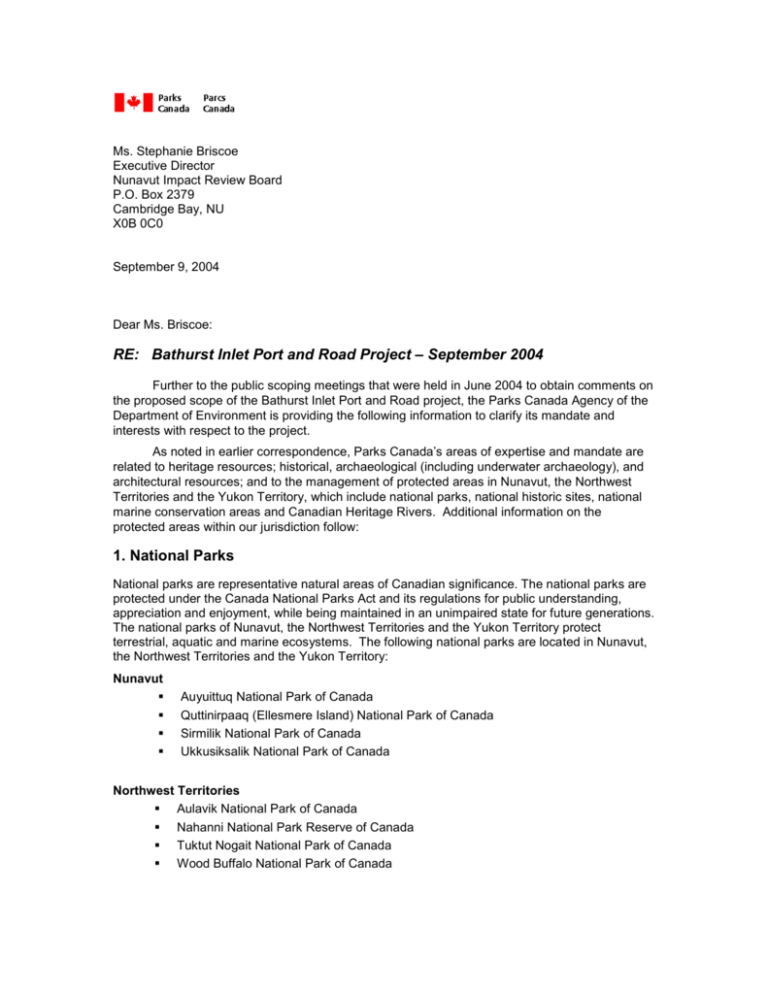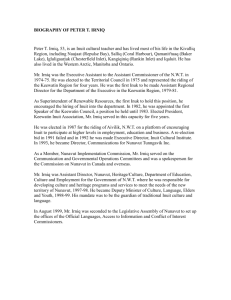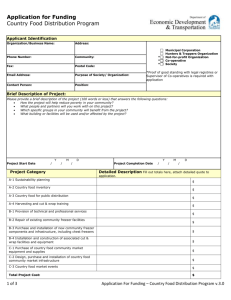040909-03UN114-Parks Canada Scoping
advertisement

Ms. Stephanie Briscoe Executive Director Nunavut Impact Review Board P.O. Box 2379 Cambridge Bay, NU X0B 0C0 September 9, 2004 Dear Ms. Briscoe: RE: Bathurst Inlet Port and Road Project – September 2004 Further to the public scoping meetings that were held in June 2004 to obtain comments on the proposed scope of the Bathurst Inlet Port and Road project, the Parks Canada Agency of the Department of Environment is providing the following information to clarify its mandate and interests with respect to the project. As noted in earlier correspondence, Parks Canada’s areas of expertise and mandate are related to heritage resources; historical, archaeological (including underwater archaeology), and architectural resources; and to the management of protected areas in Nunavut, the Northwest Territories and the Yukon Territory, which include national parks, national historic sites, national marine conservation areas and Canadian Heritage Rivers. Additional information on the protected areas within our jurisdiction follow: 1. National Parks National parks are representative natural areas of Canadian significance. The national parks are protected under the Canada National Parks Act and its regulations for public understanding, appreciation and enjoyment, while being maintained in an unimpaired state for future generations. The national parks of Nunavut, the Northwest Territories and the Yukon Territory protect terrestrial, aquatic and marine ecosystems. The following national parks are located in Nunavut, the Northwest Territories and the Yukon Territory: Nunavut Auyuittuq National Park of Canada Quttinirpaaq (Ellesmere Island) National Park of Canada Sirmilik National Park of Canada Ukkusiksalik National Park of Canada Northwest Territories Aulavik National Park of Canada Nahanni National Park Reserve of Canada Tuktut Nogait National Park of Canada Wood Buffalo National Park of Canada Yukon Territory Ivvavik National Park of Canada Kluane National Park and Reserve of Canada Vuntut National Park of Canada. 2. National Historic Park The Pingo Canadian Landmark is currently designated as a national historic park, but will be changed soon to a national historic site under the Canada National Parks Act National Historic Sites of Canada Order. This change was pre-published in Part 1 of Canada Gazette on March 27, 2004. Final approval and publishing in Part II of the Canada Gazette is anticipated when Cabinet returns. With the change, the provisions of subsection 8(1), section 12, subsections 16(1) to (3), sections 17 to 23, subsections 24(2) and (3) and sections 25 to 32 of the Canada National Parks Act will apply to the Pingo Canadian Landmark. 3. Sites of National Historic Significance Other than the Pingo Canadian Landmark, there are no national historic sites administered by Parks Canada in the Northwest Territories or in Nunavut. Canada does however have a program of historical commemoration under the Historic Sites and Monuments Act that recognizes nationally significant places, persons, events and other aspects of Canadian history. The Minister may, by means of plaques or other signs or in any other suitable manner mark or otherwise commemorate historic places and make agreements with any persons for marking or commemorating historic places pursuant to this Act and for the care and preservation of any places so marked or commemorated. The Parks Canada Agency does provide advice and support to these historic places. The following is a list of sites designated of national historic significance in both the Northwest Territories and Nunavut, and a designated historic event in the Yukon Territory: Sites of Significance in the Northwest Territories Not Administered by Parks Canada Church of Our Lady of Good Hope, Fort Good Hope, Northwest Territories Déline Fishery / Franklin's Fort, Déline, Northwest Territories Ehdaa, Fort Simpson, Northwest Territories Fort McPherson, Fort McPherson, Northwest Territories Fort Reliance, Reliance, Northwest Territories Fort Resolution, Fort Resolution, Northwest Territories Fort Simpson, Fort Simpson, Northwest Territories Grizzly Bear Mountain and Scented Grass Hills, Grizzly Bear Mountain and Scented Grass Hills, Northwest Territories Hay River Mission Sites, Hay River Indian Reserve, Northwest Territories Kittigazuit Archaeological Sites, Kittigazuit, Northwest Territories Nagwichoonjik (Mackenzie River), Tsiigehtchic, Northwest Territories Parry's Rock Wintering Site, Winter Harbour, Melville Island, Northwest Territories Sites of Significance in Nunavut Not Administered by Parks Canada Arvia'juaq and Qikiqtaarjuk, Qikiqtarjuac, Sentry Island, Nunavut Beechey Island Sites, Beechey Island, Nunavut Blacklead Island Whaling Station, Blacklead Island, Nunavut Bloody Falls, Kugluktuk, Nunavut Erebus and Terror, Erebus Bay, King William Island, Nunavut Fall Caribou Crossing, Kazan River / Baker Lake, Nunavut Igloolik Island Archaeological Sites, Igloolik Island, Nunavut Inuksuk, Enukso Point, Nunavut Kekerten Island Whaling Station, Kekerten Island, Nunavut Kodlunarn Island, Kodlunarn Island, Frobisher Bay, Nunavut Port Refuge, Port Refuge, Devon Island, Nunavut Event of Significance in Yukon Territory Herschel Island Historical Event, Herschel Island, Yukon Territory 4. Canadian Heritage Rivers The Canadian Heritage Rivers System (CHRS) was established in 1984 by the federal, provincial and territorial governments to conserve and protect the best examples of Canada’s river heritage, to give them national recognition, and to encourage the public to enjoy and appreciate them. It is a cooperative program of the governments of Canada, all 10 provinces, and the three territories. A Board, which includes participation by Parks Canada, works to develop a management plan, or heritage strategy, to ensure the river will be managed to conserve its outstanding natural, cultural and/or recreational values. Following is a listing of the rivers that have been designated as heritage rivers in the area of interest: Nunavut Soper River Coppermine River (nominated) Northwest Territories Arctic Red River Yukon Territory Bonnet Plume River Parks Canada Concerns with Respect to the Project / Recommended Scope of Project/Scope of Assessment 1. Although the project lies entirely within the Kitikmeot region of Nunavut, activities associated with the Bathurst Inlet Port Proposal, including marine traffic for the delivery of fuel and bulk cargo and for shipping of base metal concentrates, as well as road development, will undoubtedly be key to opening up the Central Arctic to increased levels of mining and other human activity in years to come. These activities have the potential to adversely impact on the ecological integrity of protected areas managed by Parks Canada listed above. Although the scope of the project as presently described is limited to the construction and operation of the Bathurst Inlet Port and Road project, the scope of the assessment should include the cumulative effects of the project combined with past projects and future projects and activities which will occur in the area. The cumulative effects assessment should include the imminent development of the Izok mine and its associated road access, and the potential for increased traffic along shipping lanes from both eastern and western approaches. Although not contained within the scope of the present submission, analysis of the cumulative impacts on the development of this port and road system and the future westward expansion of roads and subsequent mining operations towards the boundaries of Tuktut Nogait National Park also needs to be undertaken. Tuktut Nogait National Park is located west of the proposed development area. The park protects the important calving grounds for the Bluenose West caribou herd that numbers approximately 75,000 adults. This co-operatively managed herd is important to Inuit and Dene subsistence harvesters from Nunavut and the Northwest Territories. 2. Eastern shipping routes have the potential to impact on the national parks in Nunavut, specifically Sirmilik National Park and Auyuittuq National Park. Sirmilik National Park at the north end of Baffin Island contains near-shore marine components within its boundaries. Shipping activity could pose a threat to sensitive arctic marine environments contained within the national park as well as to those of the greater marine system. The accidental release of petroleum products in the northern marine environment has the potential to create significant adverse effects to both marine and terrestrial ecosystems. There are limited, if any, infrastructure / emergency facilities to deal with spills. 3. Although the current proposal discusses eastern shipping routes only, the opening of the port will inevitably lead to the eventual opening of western shipping routes. This would result in increased traffic along the coastline of Ivvavik National Park, which also contains nearshore marine components within its boundaries. As discussed above, shipping activity could pose a threat to both marine and terrestrial ecosystems in an area where infrastructure / emergency facilities to deal with spills are limited or non-existing. This activity could also result in impacts to the Coppermine River estuary. 4. The proposed pit and quarry locations are potential sites for heritage resources. With the number of proposed sites for gravel and rock extraction, and the associated high potential for human occupation of these sites, heritage resource surveys of these locations are required. Failure to do so has the potential to result in irreversible loss of heritage resources. 5. Similarly, the port site heritage resources need to be evaluated for undersea heritage resources. Canadian waterways were used extensively by Inuit and non-Inuit peoples for travel and exploration, and the wrecks of ships constitute underwater heritage resources that are unique and irreplaceable. Surveying of the new sections of the marine route for underwater heritage resources is recommended; in addition to surveying, mitigation to protect underwater heritage resources from irretrievable loss needs to be proposed. 6. In response to concerns about navigational challenges posed by the Bathurst Inlet, an alternative proposal may involve relocating the port and associated infrastructure to Kugluktuk. This alternative would result in the siting of the port and infrastructure considerably closer to existing park boundaries (i.e. Tuktut Nogait National Park) and to planned extensions that encompass Bluenose Lake to the east and areas north of Great Bear Lake to the south. The integrity of the national park could be significantly impacted by this alternative. We trust that this information will provide some clarification on the areas of interest and issues of concern to the Parks Canada Agency. If you have any questions or require clarification, please contact one of the Parks Canada representatives below: Name: Address: Telephone: FAX: E-Mail: Suzanne Therrien-Richards, Environmental Science and Assessment Coordinator Western Canada Service Centre 3rd Floor, 145 McDermot Avenue, Winnipeg, Manitoba R3B 0R9 (204) 984-5719 (204) 983-0031 Suzanne.Richards@pc.gc.ca Name: Field Unit: Address: Attention: FAX: E-Mail: Ed McLean, Manager, Resource Conservation Western Arctic District Field Unit Box 1840, Inuvik, NT X0E 0T0 Telephone: (867) 777-8818 (867) 777-8820 Ed.McLean@pc.gc.ca Name: Field Unit: Address: Telephone: FAX: E-Mail: Vicki Sahanatien, Chief, Resource Conservation Nunavut Field Unit P.O. Box 278, Iqaluit, NU X0A 0H0 (867) 975-4672 (867) 975-4674 Vicki.Sahanatien@pc.gc.ca Original signed by: Elizabeth Seale Superintendent, Nunavut Field Unit Unit Parks Canada Agency (867) 975-4683 Alan Fehr Superintendent, Western Arctic Field Parks Canada Agency (867) 777-8801





